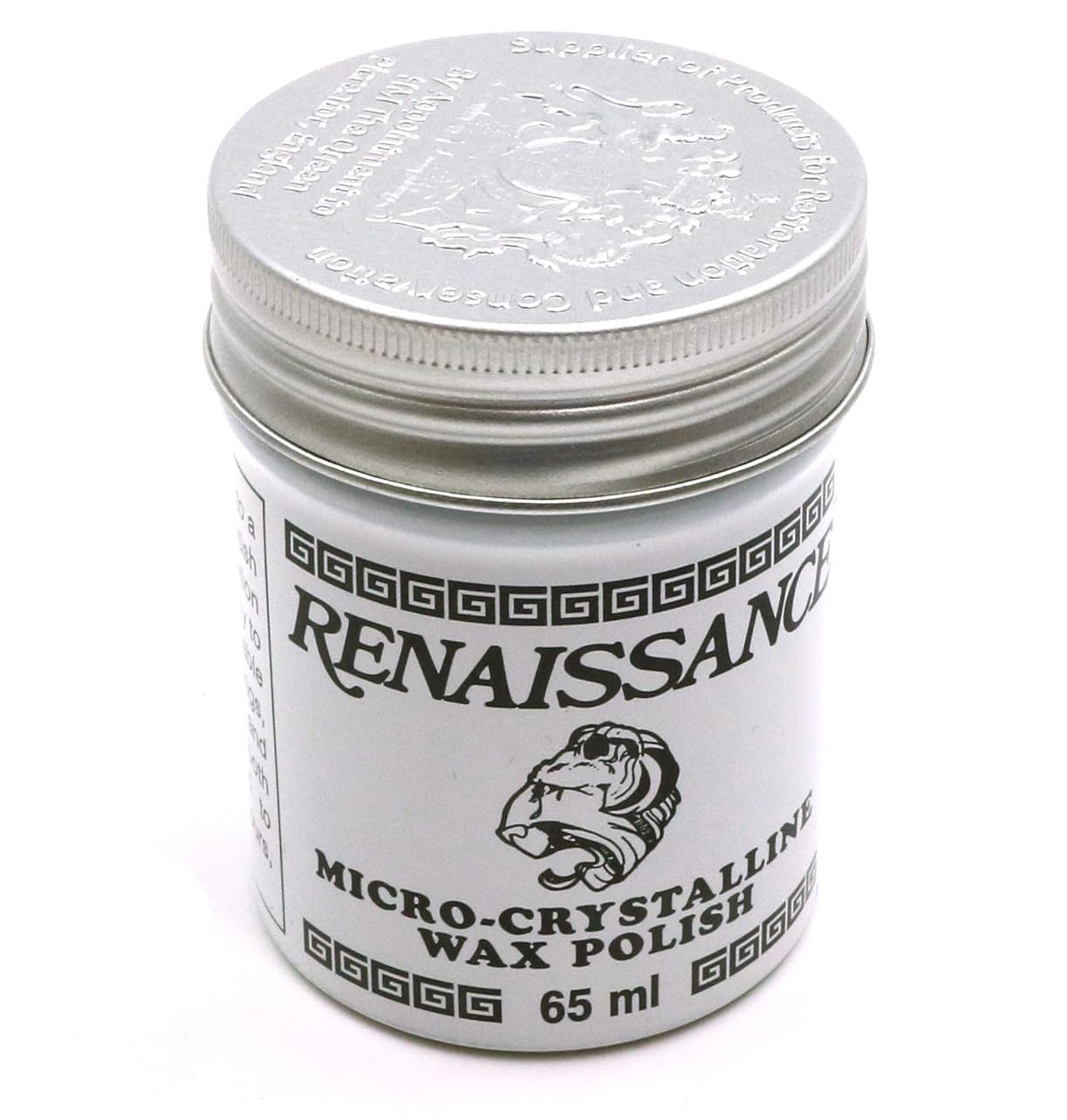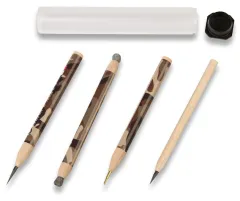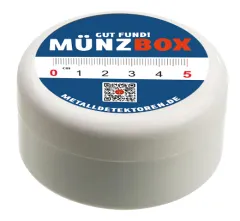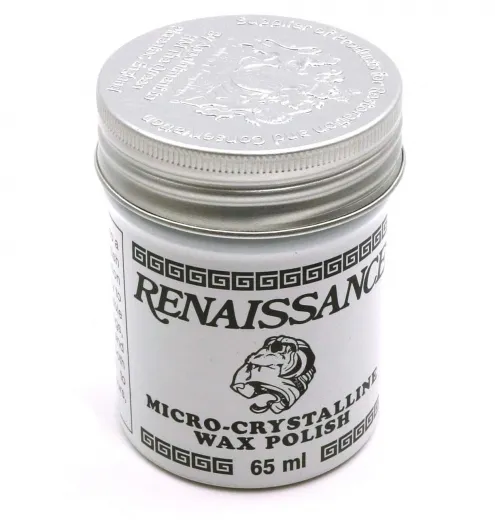Products description Recognised as a standard product by museums worldwide!Renaissance ™ wax polish was originally formulated in the early 1950s in the research laboratories of the British Museum in response to a discussion among museum technicians at an international conference on art conservation.
Recognised as a standard product by museums worldwide!Renaissance ™ wax polish was originally formulated in the early 1950s in the research laboratories of the British Museum in response to a discussion among museum technicians at an international conference on art conservation.
In accelerated ageing tests, the British Museum scientist found that all current commercial waxes based on the usual natural waxes (beeswax and carnauba wax) contained acids that could, over time, degrade the original finishes of the national historic furniture collections. He rejected them all and investigated the new so-called "fossil" or microcrystalline waxes, which were refined from crude oil. With their different properties depending on their geographical origin, the new artificial waxes could be precisely blended to meet the needs of many industries, from cosmetics and pharmaceuticals to heavy engineering. In this way, the waxes combined the best properties of nature with the benefits of modern technology.
The blend that emerged from this research was developed for the long-term protection of all classes of museum exhibits. At last, museum technicians and others who cared for important collections could use wax polish that would neither cause future conservation problems nor compromise the intrinsic values of their treasures. The varnish was finally commercially produced and distributed in 1968 by the London-based company Picreator Enterprises Ltd. under the trade name "Renaissance". The product was quickly accepted in the international museum world and has become a widely recognised standard conservation material - probably the most widely used due to its almost unlimited use.
What makes Renaissance Wax so different?
It has a crystalline structure that is much finer than completely natural waxes, a property that gives it highly efficient moisture resistance. Countless statues and monuments in the streets of the city are now protected from weather corrosion by Renaissance wax. Weapons and armour, steel and kitchen utensils made of brass and copper in historic house museums are kept bright and corrosion-free.
If the wax film is applied thinly and rubbed out to a full shine, it is (and remains) crystal clear without discolouring the wax or the underlying surface. Renaissance wax is acid-free (pH-neutral) and does not damage even sensitive materials. For example, photographs for exhibitions or of historical value are waxed to protect the image from the natural acidity of the hand or environmental pollutants. The wax does not even colour or darken white paper.
Properties
- Chemical description: Mixture of microcrystalline waxes in special petrol.
- Form: solid
- Solubility in water: insoluble
Included in the scope of delivery
- Renaissance polishing wax 65ml
- 1 x instruction
Customers who bought this product also bought the following products:
4-piece cleaning pen set for cleaning floor finds, coins, jewelry, medals, badges, etc. 19,95 EUR19 % VAT incl.The Gut Fund coin box is the ideal companion when searching in the field to protect small finds such as coins, jewellery etc.. Simply moisten the inner pad with water, then insert the coins one after the other into the 11 slots. Depending on the diameter, there is space for up to 30 coins in th... 6,49 EUR19 % VAT incl.These Le Crayon pencils are specially designed for the professional cleaning of coins and objects. They are designed to minimise damage to the object when used. 29,98 EUR VAT excl.
Diesen Artikel teilen:
Kontakt
Beratung
Professionelle & kompetente Metalldetektoren-Beratung für Einsteiger & Fortgeschrittene
Mo.- Fr.: 9:00 - 16.00 UhrBestellung
Deinen Metalldetektor jetzt telefonisch bestellen und schnellen Versand sichern: +49 173 870 70 75 Services
Reparaturservice
Technische Beratung
Inzahlungsnahme
Finanzierungen
 Recognised as a standard product by museums worldwide!Renaissance ™ wax polish was originally formulated in the early 1950s in the research laboratories of the British Museum in response to a discussion among museum technicians at an international conference on art conservation.
Recognised as a standard product by museums worldwide!Renaissance ™ wax polish was originally formulated in the early 1950s in the research laboratories of the British Museum in response to a discussion among museum technicians at an international conference on art conservation.In accelerated ageing tests, the British Museum scientist found that all current commercial waxes based on the usual natural waxes (beeswax and carnauba wax) contained acids that could, over time, degrade the original finishes of the national historic furniture collections. He rejected them all and investigated the new so-called "fossil" or microcrystalline waxes, which were refined from crude oil. With their different properties depending on their geographical origin, the new artificial waxes could be precisely blended to meet the needs of many industries, from cosmetics and pharmaceuticals to heavy engineering. In this way, the waxes combined the best properties of nature with the benefits of modern technology.
The blend that emerged from this research was developed for the long-term protection of all classes of museum exhibits. At last, museum technicians and others who cared for important collections could use wax polish that would neither cause future conservation problems nor compromise the intrinsic values of their treasures. The varnish was finally commercially produced and distributed in 1968 by the London-based company Picreator Enterprises Ltd. under the trade name "Renaissance". The product was quickly accepted in the international museum world and has become a widely recognised standard conservation material - probably the most widely used due to its almost unlimited use.
What makes Renaissance Wax so different?
It has a crystalline structure that is much finer than completely natural waxes, a property that gives it highly efficient moisture resistance. Countless statues and monuments in the streets of the city are now protected from weather corrosion by Renaissance wax. Weapons and armour, steel and kitchen utensils made of brass and copper in historic house museums are kept bright and corrosion-free.
If the wax film is applied thinly and rubbed out to a full shine, it is (and remains) crystal clear without discolouring the wax or the underlying surface. Renaissance wax is acid-free (pH-neutral) and does not damage even sensitive materials. For example, photographs for exhibitions or of historical value are waxed to protect the image from the natural acidity of the hand or environmental pollutants. The wax does not even colour or darken white paper.
Properties
- Chemical description: Mixture of microcrystalline waxes in special petrol.
- Form: solid
- Solubility in water: insoluble
Included in the scope of delivery
- Renaissance polishing wax 65ml
- 1 x instruction
4-piece cleaning pen set for cleaning floor finds, coins, jewelry, medals, badges, etc.
19,95 EUR
19 % VAT incl.
The Gut Fund coin box is the ideal companion when searching in the field to protect small finds such as coins, jewellery etc.. Simply moisten the inner pad with water, then insert the coins one after the other into the 11 slots. Depending on the diameter, there is space for up to 30 coins in th...
6,49 EUR
19 % VAT incl.
These Le Crayon pencils are specially designed for the professional cleaning of coins and objects. They are designed to minimise damage to the object when used.
29,98 EUR
VAT excl.
Kontakt
Beratung
Professionelle & kompetente Metalldetektoren-Beratung für Einsteiger & Fortgeschrittene
Mo.- Fr.: 9:00 - 16.00 Uhr
Professionelle & kompetente Metalldetektoren-Beratung für Einsteiger & Fortgeschrittene
Mo.- Fr.: 9:00 - 16.00 Uhr
Bestellung
Deinen Metalldetektor jetzt telefonisch bestellen und schnellen Versand sichern: +49 173 870 70 75
Deinen Metalldetektor jetzt telefonisch bestellen und schnellen Versand sichern: +49 173 870 70 75
Services
Reparaturservice
Technische Beratung
Inzahlungsnahme
Finanzierungen
Reparaturservice
Technische Beratung
Inzahlungsnahme
Finanzierungen
DETEKTOREN & ZUBEHÖR
BEWERTE UNS
Unsere Garantie
Informationen
Hobby Tipps
Welcome back!
Last viewed:
Manufacturer
Picreator Enterprises Ltd
Shipping country







